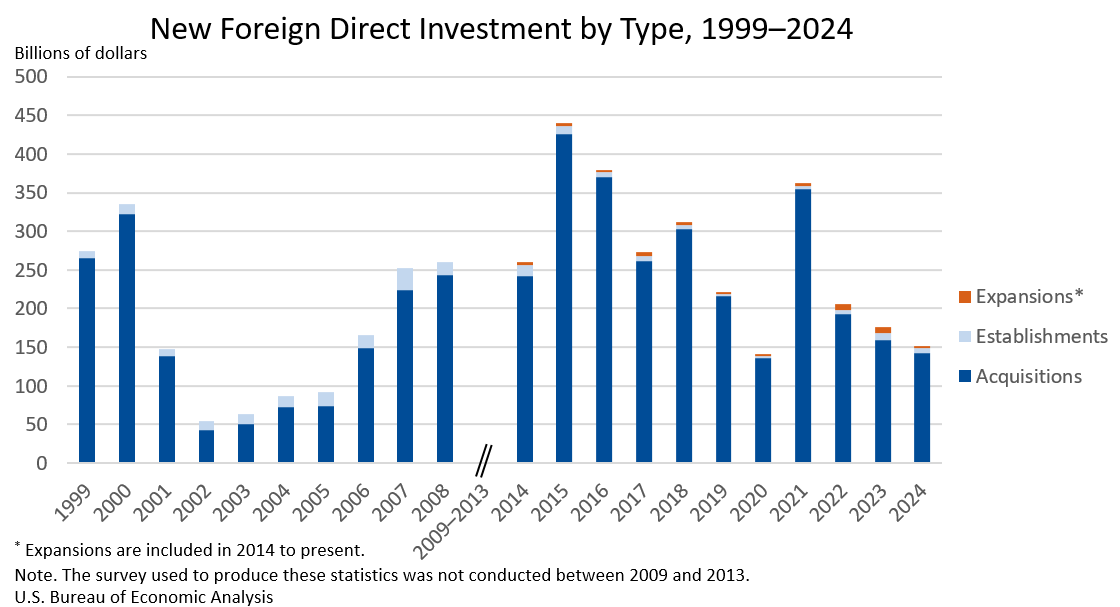Bureau of Economic Analysis
New Foreign Direct Investment in the United States, 2024
Expenditures by foreign direct investors to acquire, establish, or expand U.S. businesses totaled $151.0 billion in 2024, according to preliminary statistics released today by the U.S. Bureau of Economic Analysis. Expenditures decreased $24.9 billion, or 14.2 percent, from $176.0 billion (revised) in 2023 and were below the annual average of $277.2 billion for 2014–2023. As in previous years, acquisitions of existing U.S. businesses accounted for most of the expenditures.
Principal Federal Economic Indicators
Noteworthy
- 2025 News Release Schedule
- Innovation at BEA
- 2025 Annual Updates
- New! Services Trade Data for More Countries
- Data Tool: Trade in Value Added
- Distribution of State Personal Income
- Updated: RIMS II Regional Multipliers
- Arts and Culture
- Space Economy
- FDI Now in State BEARFACTS
- Quick Guide: Price Indexes
The Latest
Marine Economy Satellite Account, 2022
The Marine Economy Satellite Account statistics released today by the U.S. Bureau of Economic Analysis show the marine economy accounted for $476.2 billion, or 1.8 percent, of current-dollar U.S. gross domestic product in 2022, an increase from $424.2 billion, or 1.8 percent, in 2021. The marine economy accounted for 1.7 percent, or $776.9 billion, of current-dollar gross output.
Marine Economy Satellite Account, 2022
The Marine Economy Satellite Account statistics released today by the U.S. Bureau of Economic Analysis show the marine economy accounted for $476.2 billion, or 1.8 percent, of current-dollar U.S. gross domestic product (GDP) in 2022, an increase from $424.2 billion, or 1.8 percent, in 2021. The marine economy accounted for 1.7 percent, or $776.9 billion, of current-dollar gross output.
April 2024 Trade Gap is $74.6 Billion
The U.S. goods and services trade deficit increased from $68.6 billion in March (revised) to $74.6 billion in April, as imports increased more than exports. The goods deficit increased $5.9 billion to $99.2 billion, and the services surplus decreased $0.1 billion to $24.7 billion.
U.S. International Trade in Goods and Services, April 2024
The U.S. goods and services trade deficit increased in April 2024 according to the U.S. Bureau of Economic Analysis and the U.S. Census Bureau. The deficit increased from $68.6 billion in March (revised) to $74.6 billion in April, as imports increased more than exports. The goods deficit increased $5.9 billion in April to $99.2 billion. The services surplus decreased $0.1 billion in April to $24.7 billion.
U.S. International Trade in Goods and Services, Annual Revision
The U.S. goods and services trade deficit increased in April 2024 according to the U.S. Bureau of Economic Analysis and the U.S. Census Bureau. The deficit increased from $68.6 billion in March (revised) to $74.6 billion in April, as imports increased more than exports. The goods deficit increased $5.9 billion in April to $99.2 billion. The services surplus decreased $0.1 billion in April to $24.7 billion.
Coming Soon: More International Investment Position Data, Quarterly Detail on Prices, Exchange Rates
BEA will begin publishing on June 26 new quarterly detail for the U.S. international investment position (IIP), a statistical balance sheet that presents the dollar value of U.S. financial assets and liabilities with respect to other countries at the end of each quarter and year. The IIP statistics are published in BEA news releases and interactive data tables in March, June, September, and December.
Personal Income and Outlays, April 2024
Personal income increased $65.3 billion (0.3 percent at a monthly rate) in April. Disposable personal income —personal income less personal current taxes—increased $40.2 billion (0.2 percent). Personal outlays—the sum of personal consumption expenditures, personal interest payments, and personal current transfer payments—increased $42.8 billion (0.2 percent) and consumer spending increased $39.1 billion (0.2 percent). Personal saving was $744…
Personal Income and Outlays, April 2024
Personal income increased $65.3 billion (0.3 percent at a monthly rate) in April. Disposable personal income (DPI)—personal income less personal current taxes—increased $40.2 billion (0.2 percent). Personal outlays—the sum of personal consumption expenditures (PCE), personal interest payments, and personal current transfer payments—increased $42.8 billion (0.2 percent) and consumer spending increased $39.1 billion (0.2 percent). Personal saving…
Gross Domestic Product (Second Estimate) Corporate Profits (Preliminary Estimate) First Quarter 2024
Real gross domestic product increased at an annual rate of 1.3 percent in the first quarter of 2024, according to the “second” estimate. In the fourth quarter of 2023, real GDP increased 3.4 percent. The GDP estimate for the first quarter was revised down 0.3 percentage point from the “advance” estimate, primarily reflecting a downward revision to consumer spending.
Gross Domestic Product, First Quarter 2024 (Second Estimate) and Corporate Profits (Preliminary)
Real gross domestic product (GDP) increased at an annual rate of 1.3 percent in the first quarter of 2024, according to the "second" estimate. In the fourth quarter of 2023, real GDP increased 3.4 percent. The increase in the first quarter primarily reflected increases in consumer spending and housing investment that were partly offset by a decrease in inventory investment. Imports, which are a subtraction in the calculation of GDP,…




